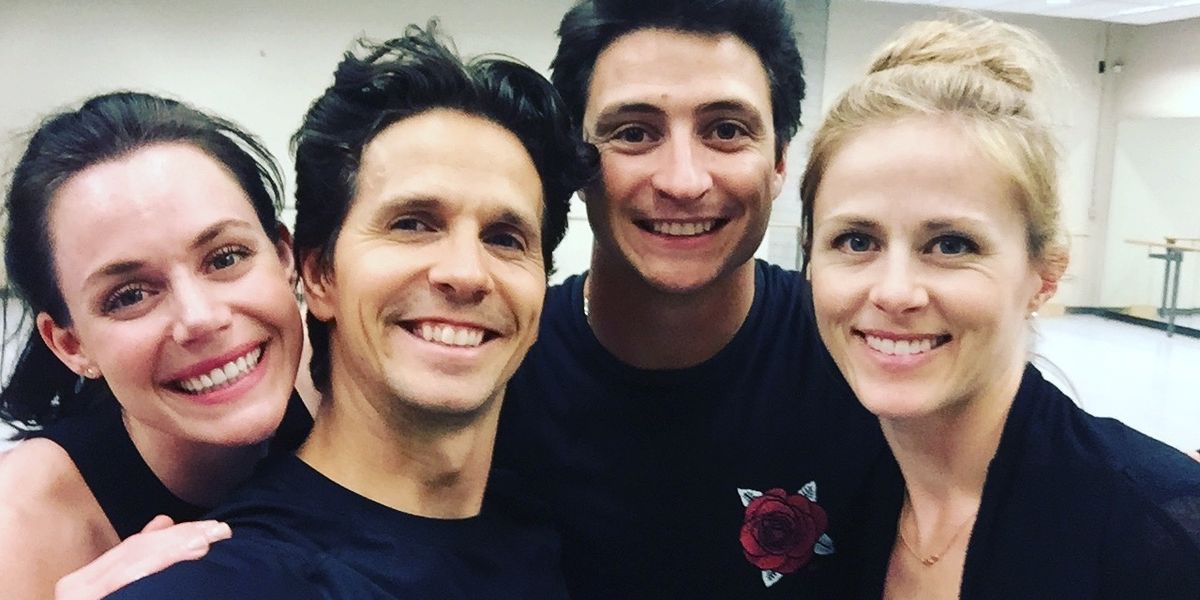Guess Who's Choreographing Tessa Virtue and Scott Moir's New Ice Dancing Show
Guillaume Côté is best known as a celebrated principal dancer with the National Ballet of Canada, his artistic home since 1998. But he’s also an adventurous choreographer. He has been choreographic associate at NBoC since 2013, is the artistic director of the Festival des Arts de Saint-Sauveur and has worked with everyone from actors to models to opera singers. “I never shy away from an opportunity that is different,” Côté says. “The worst thing I can do is do the same thing twice.”
Enter the ice dancers.
Tessa Virtue and Scott Moir, the Canadian ice dancing team who became the most decorated Olympic figure skaters in history at Pyeonchang in 2018, are co-producing Rock the Rink, a new skating show that will tour Canada this fall. And who did they ask to choreograph their new program? None other than Côté. We spoke to the choreographer about the experience.
How he got involved with Rock the Rink
Virtue had previously met Côté, and she occasionally name-checked him as someone she would love to work with. The timing had never been right to collaborate, but now, with a new skating show on the horizon, it seemed the moment had arrived. “I try to do things that haven’t been done, especially when it comes to context,” Côté says. “I really love ballet, but I do like to shake it up a bit. We live in this age where I think it’s our responsibility to try to marry different art forms and fuse different disciplines, and this was the perfect project to do with Scott and Tessa.”
How Rock the Rink differs from other ice shows—or what you see in competition
Usually, skating shows are not unlike ballet galas: The stars come in, do their variations and leave. While it’s certainly thrilling to see dancers or figure skaters in a series of show-stopping numbers, with Rock the Rink, Virtue and Moir are hoping to create a more cohesive theatrical experience. “There’s a desire, I think, in the world of skating to start pushing the envelope artistically,” Côté says. Ballet dancers are almost spoiled for choice: Companies increasingly run the gamut in terms of repertoire, and in a single season, dancers perform dramatic roles in full-lengths and edgy abstract work. “How amazing would it be for a figure skater or an ice dancer to get to do a role like Manon or Des Grieux?” Côté muses.
In addition to overhauling the format of the show, Virtue and Moir are challenging themselves—their own style and way of moving. Without competitive parameters (ice dancing choreography is subject to a slew of rules, including the duration and height of lifts), the pair is free to follow their interests.
What Virtue and Moir are like in the studio
“I don’t know why, but I was very surprised at how incredible they are as just dancers,” Côté admits. “I was afraid that on skates, you have 15 tricks and that’s what you are. But Tessa and Scott are extremely good dancers. Ballet is not their strong suit, but we were able to tap into what they’re good at. Scott can really toss her like crazy—they were happy to try lifts they’d never done before. For them it was liberating. And Tessa is the most wonderfully athletic mover. She’s so active and so strong.”
He also notes that Virtue and Moir were “amazed at how much terminology we have—but they kind of know how to do the steps anyway,” which made for a few funny moments. “You’re going, ‘Oh, this is a temps levé arabesque there.’ And they’re like, ‘What’s a temps levé?’ And you’re like, right, ‘It just means you jump on one leg.’ They pick up so fast, it’s really quite incredible.”
How Côté choreographed for the ice
“At first, I was making things I thought could work when they were on skates,” Côté says. “After a certain point, they said, ‘Make what you want and we’ll transpose it to the ice.’ If you watch how skaters use space, the speed, how they travel from one place to another—it’s so beautiful, it’s so seamless. That’s what is amazing about skating, so you don’t want to get rid of that. You don’t want to make something where the difficulty level requires them to stand still.” They’re also playing with narrative, although Côté cautions, “It’s not going to be a three act ballet or anything. It came out very organically.”
 Guillaume Côté
Guillaume Côté
Karolina Kuras, Courtesy Côté
What dancers could learn from figure skaters
One thing that especially fascinated Côté was the idea of mental training. Virtue and Moir have been open about the work they put in off the ice. “They actually stopped going on the ice for a little while to work on their brains, their behavior and the way to handle stress to perform better,” Côté says, somewhat incredulously. “As a ballet dancer, we’re always training our bodies. It would be beneficial for dancers to not just do an ab workout but also do mental workouts, so your brain and nerves are trained properly in order to perform at the highest level. We all have maximum potential and it’s a matter of offering all parts of the training.”




